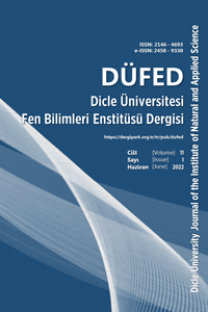Asenkron Motor Arıza Tespitinde Akım Uzay Örüntü Tanıma Sisteminin Kullanılması
Induction Motor Fault Detection Using Current Space Pattern Recognition
___
- [1] O. V. Thorsen and M. Dalva, “A survey of faults on induction motors in offshore oil industry, petrochemical industry, gas terminals and oil refineries,” in Proceedings of IEEE Petroleum and Chemical Industry Technical Conference (PCIC ’94), pp. 1–9.
- [2] P. . J. Tavner, “Review of condition monitoring of rotating electrical machines,” IET Electr. Power Appl., vol. 2, no. 4, pp. 215–247, 2008.
- [3] W. T. Thomson and M. Fenger, “Current signature analysis to detect induction motor faults,” IEEE Ind. Appl. Mag., vol. 7, no. 4, pp. 26–34, 2001.
- [4] G. B. Kliman, R. A. Koegl, J. Stein, R. D. Endicott, and M. W. Madden, “Noninvasive detection of broken rotor bars in operating induction motors,” IEEE Trans. Energy Convers., vol. 3, no. 4, pp. 873–879, 1988.
- [5] Ye Zhongming and Wu Bin, “A review on induction motor online fault diagnosis,” in Proceedings IPEMC 2000. Third International Power Electronics and Motion Control Conference (IEEE Cat. No.00EX435), 2000, vol. 3, pp. 1353–1358.
- [6] W. T. Thomson and I. Culbert, Current Signature Analysis for Condition Monitoring of Cage Induction Motors : Industrial Application and Case Histories. .
- [7] M. El Hachemi Benbouzid, “A review of induction motors signature analysis as a medium for faults detection,” IEEE Trans. Ind. Electron., vol. 47, no. 5, pp. 984–993, 2000.
- [8] H. A. Toliyat, S. P. Waikar, and T. A. Lipo, “Analysis and simulation of five-phase synchronous reluctance machines including third harmonic of airgap MMF,” IEEE Trans. Ind. Appl., vol. 34, no. 2, pp. 332–339, 1998.
- [9] M. Wolkiewicz and C. T. Kowalski, “On-line neural network-based stator fault diagnosis system of the converter-fed induction motor drive,” in IECON Proceedings (Industrial
- [10] R. M. Tallam et al., “A Survey of Methods for Detection of Stator-Related Faults in Induction Machines,” IEEE Trans. Ind. Appl., vol. 43, no. 4, pp. 920–933, 2007.
- [11] Q. Wu and S. Nandi, “Fast single-turn sensitive stator interturn fault detection of induction machines based on positiveand negative-sequence third harmonic components of line currents,” in IEEE Transactions on Industry Applications, 2010, vol. 46, no. 3, pp. 974–983.
- [12] A. M. Trzynadlowski and E. Ritchie, “Comparative investigation of diagnostic media for induction motors: a case of rotor cage faults,” IEEE Trans. Ind. Electron., vol. 47, no. 5, pp. 1092–1099, 2000.
- [13] P. Carbonetto, G. Dorkó, C. Schmid, H. Kück, and N. De Freitas, “Learning to recognize objects with little supervision,” Int. J. Comput. Vis., vol. 77, no. 1–3, pp. 219–237, 2008.
- [14] O. Gloger, M. Ehrhardt, T. Dietrich, O. Hellwich, K. Graf, and E. Nagel, “A threestepped coordinated level set segmentation method for identifying atherosclerotic plaques on MR-images,” Commun. Numer. Methods Eng., vol. 25, no. 6, pp. 615–638, 2009.
- [15] S. Wang, F. lai Chung, and F. Xiong, “A novel image thresholding method based on Parzen window estimate,” Pattern Recognit., vol. 41, no. 1, pp. 117–129, 2008.
- [16] Y. J. Zhang, “Influence of segmentation over feature measurement,” Pattern Recognit. Lett., vol. 16, no. 2, pp. 201–206, 1995.
- ISSN: 2146-4693
- Yayın Aralığı: Yılda 2 Sayı
- Başlangıç: 2012
- Yayıncı: Dicle Üniversitesi
Buğdayda Azota Tepki ve Karlı Çeşit Tercihi
Remzi ÖZKAN, İrfan ÖZBERK, Fethiye ÖZBERK, Merve BAYHAN
Asenkron Motor Arıza Tespitinde Akım Uzay Örüntü Tanıma Sisteminin Kullanılması
Birgül GERGERLİ, Ahmet YILMAZ, Mehmet YILDIRIM
Haşhaş ezmesi çeşidinin bisküvi kalite karakteristikleri üzerine etkisi
Diyarbakır'da sera işletmelerinin durum analizi
Songül AKIN, Abdurrahman KARA, Vedat PİRİNÇ, Zafer AKTÜRK
Ferhat KIZILGEÇİ, Mehmet YILDIRIM, Cuma AKINCI, Önder ALBAYRAK, Uğur SESİZ, Nihan TAZEBAY
